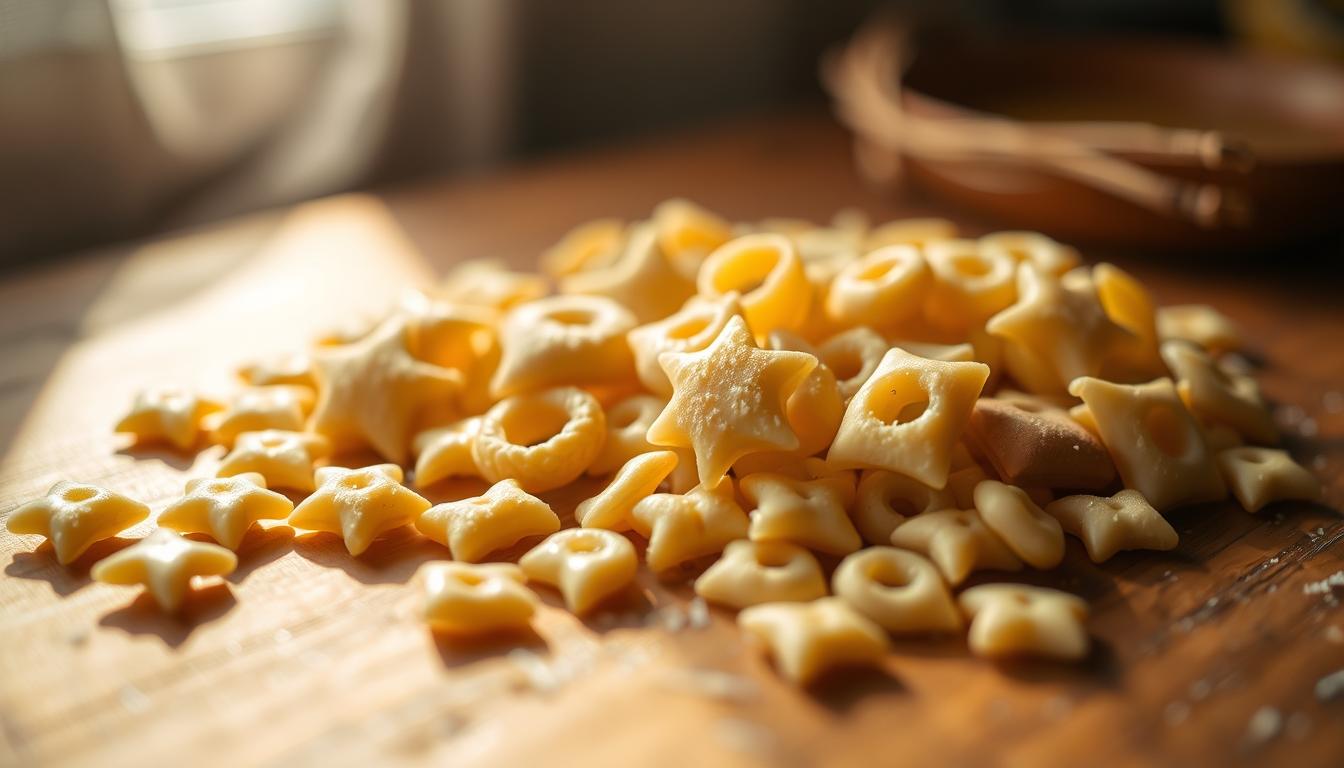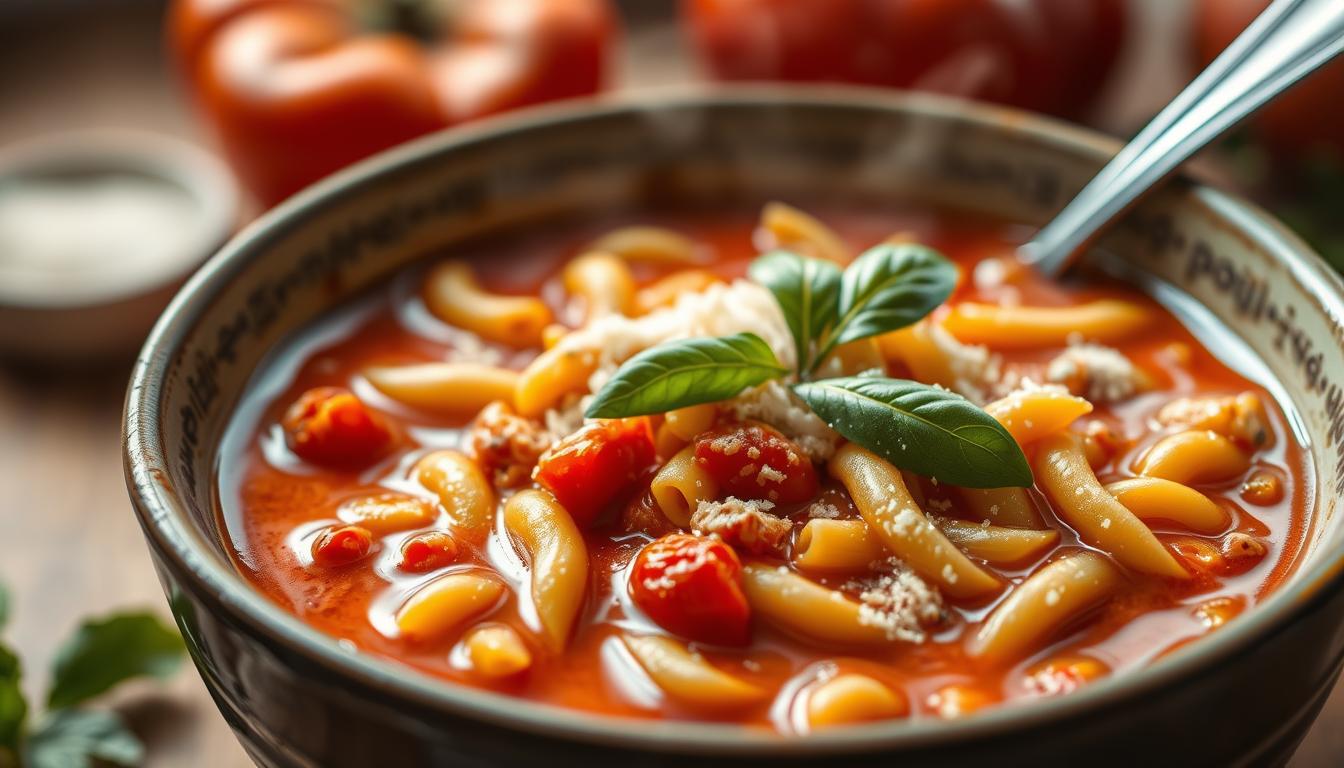The Best Pastina Soup Recipe for a Comforting Meal
Table of Contents
There’s something magical about a dish that feels like coming home. Whether you’re battling a chilly evening or seeking solace after a long day, few things wrap you in warmth quite like a steaming bowl of Italian tradition. This humble creation has been passed down through generations, earning its reputation as “Italian penicillin” for good reason.
Imagine transforming basic pantry staples into something extraordinary in just 25 minutes. That’s the beauty of this timeless classic – it turns simplicity into pure comfort. Every spoonful carries the weight of family kitchens and shared memories, yet adapts effortlessly to modern needs.
You’ll discover how this versatile favorite works equally well as weeknight dinner or nourishing remedy. From its cultural roots to clever ingredient swaps for various diets, we’ll explore what makes this dish endure. Let’s uncover why it continues to warm hearts and bellies across generations.
Embracing Comfort: Introduction to Pastina Soup
When illness strikes, Italian families reach for a centuries-old remedy simmering on the stove. At its core lies pastina – a term meaning “little pasta” that perfectly describes these bite-sized shapes. Their small size allows them to cook quickly while absorbing rich flavors from savory broths.
The Warm Legacy of an Italian Classic
This dish earned its “Italian penicillin” nickname through generations of healing. Families swear by its power to soothe sore throats and lift spirits. The magic lies in the balance: starchy pasta thickens the broth naturally, creating a velvety texture that’s gentle on upset stomachs.
| Traditional Approach | Modern Twist | Key Benefit |
|---|---|---|
| Star-shaped pastina | Gluten-free grains | Diet flexibility |
| Homemade chicken broth | Vegetable stock | Plant-based options |
| Parmesan rind simmering | Miso paste addition | Umami boost |
How This Dish Became a Comfort Staple
Italian grandmothers perfected the art of transforming basic ingredients into nurturing meals. The broth’s steam opens congested airways, while warm liquid hydrates the body. This combination of practical nutrition and emotional care makes it a cross-generational favorite.
In Italian-American communities, the recipe evolved while keeping its comforting essence. Today, it bridges cultural heritage with contemporary kitchens, proving that some traditions only grow more valuable with time.
Essential Ingredients for a Perfect Pastina Soup
The foundation of any memorable dish lies in its building blocks. Selecting the right components ensures balanced flavors and textures that work harmoniously. Let’s explore what transforms simple elements into a soul-warming creation.

Fresh Vegetables and Aromatics
Onion, carrots, and celery form the flavor trinity in Italian cooking. Diced brown onion adds sweetness, while celery contributes earthy notes. Carrots bring natural sugars that balance savory broths. Garlic cloves, minced or crushed, infuse the base with depth.
Choose low-sodium chicken or vegetable broth to control salt levels. Homemade versions offer richer taste, but store-bought works well. For plant-based diets, mushroom stock adds umami without animal products.
| Broth Type | Flavor Profile | Best For |
|---|---|---|
| Homemade Chicken | Rich, collagen-forward | Traditionalists |
| Low-Sodium Vegetable | Light, herbaceous | Dietary flexibility |
| Miso-Enhanced | Savory, complex | Modern twists |
Star-shaped pastina cooks faster than larger varieties. Alternatives like ditalini hold broth in their tubes, creating bursts of flavor. Acini di pepe offers a delicate texture for smoother consistencies.
Optional enhancers elevate the experience:
- Parmesan rind simmered in broth adds creamy saltiness
- Bay leaf introduces subtle herbal undertones
- Fresh parsley brightens each bowl before serving
Finish with quality olive oil for richness or red pepper flakes for heat. These details turn basic ingredients into something extraordinary.
Step-by-Step pastina soup recipe Instructions
Crafting comfort food requires both art and science—let’s break down the process. We’ll focus on three critical phases: vegetable preparation, broth development, and pasta perfection. Each step builds layers of flavor while maintaining the dish’s signature simplicity.
Prepping Vegetables and Building the Broth
Start with rough-chopped onion, carrots, celery, and garlic. Uneven pieces actually work better—they release more flavor during cooking. Combine these in a large pot with broth, bay leaf, and parmesan rind. Season generously before covering.
Set the heat to medium-high. Let the mixture simmer for 20 minutes—this extracts maximum nutrients from the vegetables. The broth transforms into a golden elixir, rich with umami from the cheese rind.
Cooking Techniques to Achieve Perfect Texture
After simmering, increase the heat to bring the liquid to a rolling boil. This is when you’ll add pastina. Stir every 60 seconds to prevent sticking—tiny pasta needs constant attention.
Cook for 5-6 minutes until al dente. Test a piece at the 5-minute mark. The broth should thicken slightly from the starches, creating a velvety base. Remove the pot from heat immediately once done to stop overcooking.
Timing matters most here. Use these 25 total minutes wisely: 20 for building depth, 5 for pasta perfection. Adjust salt and pepper one last time before serving.
The Rich Italian Tradition Behind Pastina Soup
In every culture, certain foods transcend mere sustenance to become symbols of care and heritage. Italy’s treasure lies in its tiny pasta varieties, where each shape tells a story of regional identity and practicality.

Discovering the Italian Penicillin
The term “Italian penicillin” captures both science and sentiment. Warm broth hydrates, while easily digestible starches provide energy. Garlic and olive oil offer natural antimicrobial properties, creating a holistic remedy.
As one Tuscan grandmother shared:
“We don’t measure love in spoons—we simmer it for hours.”
| Shape | Size | Cultural Significance |
|---|---|---|
| Stelline (stars) | 2-3mm | Childhood comfort |
| Ditalini (thimbles) | 5mm tubes | Broth retention |
| Acini di pepe | 1mm spheres | Smooth texture |
These pasta shapes mirror Mediterranean counterparts like Greek avgolemono’s orzo. Each culture developed similar solutions using local grains, proving comfort food’s universal language.
Modern studies confirm what nonnas knew: warm liquids increase nasal mucus flow by 30%. Emotional benefits matter too—the ritual of preparation fosters security during illness. This dual power explains its enduring legacy.
Tips and Tricks for Enhancing Your Broth
The soul of every great dish lies in its foundation. For those seeking to elevate their culinary creations, mastering broth techniques unlocks new dimensions of taste. Let’s explore professional methods that transform simple bases into complex flavor experiences.
Homemade vs. Store-Bought Broth
Homemade stock delivers unmatched depth through slow-simmered bones and vegetables. This method extracts collagen for silkier textures. However, quality store-bought options work beautifully when time is limited.
| Broth Type | Preparation Time | Flavor Intensity |
|---|---|---|
| Homemade | 4+ hours | Rich, layered |
| Store-Bought | Instant | Mild, adjustable |
Boost boxed versions with these tricks:
- Simmer with herb stems for 15 minutes
- Add a splash of apple cider vinegar to brighten
- Use low-sodium varieties to control salt levels
Incorporating Parmesan and Olive Oil for Depth
That leftover parmesan rind in your fridge? It’s liquid gold. Toss it into simmering broth to release savory umami notes. Freeze rinds in airtight bags for year-round access.
Finish your dish with two transformative touches:
- Drizzle extra-virgin olive oil before serving – its peppery notes cut through richness
- Shower bowls with freshly grated parmesan cheese for salty complexity
These techniques work synergistically. The oil carries aromatic compounds to your palate, while the cheese adds textural contrast. Together, they turn humble ingredients into a restaurant-worthy experience.
How to Customize and Elevate Your Pastina Soup
Every kitchen becomes a canvas when personal touches meet tradition. Whether you crave extra nourishment or crave bold flavors, this adaptable dish welcomes creative experimentation while honoring its roots.
Building Flavor Through Smart Swaps
Enhance your bowl with proteins that complement delicate broths. Shredded rotisserie chicken adds heartiness without overpowering. For plant-based versions, try crumbled tofu or lentils. As Chef Giada Rossi notes:
“The best versions reflect the cook’s personality – a pinch of daring makes it yours.”
| Traditional Add-In | Modern Alternative | Benefit |
|---|---|---|
| Shredded chicken | Plant-based crumbles | Dietary flexibility |
| Chopped carrots | Kale ribbons | Textural contrast |
| Parmesan rind | Nutritional yeast | Vegan-friendly |
Spice lovers can stir in red pepper flakes during simmering. Fresh herbs like basil or oregano add brightness when sprinkled before serving. Seasonal vegetables transform the dish – try zucchini in summer or roasted squash during fall.
Gluten-free grains like quinoa work for dietary needs. Tiny star-shaped pasta retains charm, while rice-shaped varieties offer neutral backdrops for bold additions. The key lies in balancing innovation with the broth’s comforting essence.
Serving Suggestions for a Cozy Meal
Presentation transforms nourishment into an experience. Ladle your creation into wide, shallow bowls to showcase golden broth and tiny pasta shapes. The vessel’s curve cradles heat while allowing aromas to rise gently.
Finish with a flourish: shower freshly grated parmesan across the top. Its salty crystals melt into the surface, creating flavor pockets. A drizzle of olive oil adds silky richness and catches light like liquid amber.
For color contrast, scatter chopped parsley leaves. Their bright green hue pops against creamy broth. Crusty bread makes an ideal partner – perfect for soaking up every last drop.
Adapt these ideas for other broth-based soups or grain meals. The principles remain timeless: balance textures, layer flavors, and honor the dish’s comforting soul. Simple elegance always satisfies.
FAQ
Can I substitute pastina with other pasta shapes?
Yes! Small pasta like orzo, acini di pepe, or even broken angel hair work well. Brands like Barilla or De Cecco offer similar options. Adjust cooking times based on the pasta’s thickness.
How do I store leftovers properly?
Let the soup cool completely, then transfer it to an airtight container. Refrigerate for up to 3 days. Reheat gently on the stove, adding a splash of broth or water to loosen the texture.
Is homemade broth worth the effort?
Homemade broth adds unmatched depth, but store-bought versions like Swanson or Progresso work in a pinch. Enhance them with a Parmesan rind or a drizzle of olive oil for extra richness.
Can I make this vegetarian-friendly?
Absolutely. Swap chicken broth for vegetable broth and omit cheese if needed. Add mushrooms or white beans for a hearty twist. Nutritional yeast can mimic a cheesy flavor without dairy.
What proteins pair well with this dish?
Shredded rotisserie chicken, turkey, or even cooked lentils blend seamlessly. For a lighter option, try flaked salmon or poached eggs. Adjust cooking times to avoid overcooking added proteins.
Can I freeze this for later use?
Freezing isn’t ideal due to the pasta’s texture, which may become mushy. Instead, freeze the broth base separately and cook fresh pasta when reheating for best results.
How do I prevent the pasta from absorbing too much broth?
Cook the pasta separately and add it to individual bowls before serving. This keeps the broth from thickening over time. Use a 2:1 liquid-to-pasta ratio for optimal consistency.
Are there gluten-free alternatives?
Yes! Brands like Barilla Gluten-Free or Ronzoni offer rice-based pastina substitutes. Check labels to ensure cross-contamination isn’t a concern if cooking for strict gluten-free diets.

